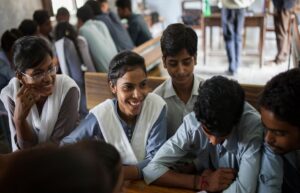With growing interest in early childhood care and education (ECCE) as a key factor in achieving better learning outcomes, governments and practitioners are trying to figure out how to have the greatest impact.
While significant work has been done in the area of ECCE, gaps remain in knowledge and capacity to define how to ensure equitable access to quality ECCE within education systems.
To understand these gaps, an online survey was sent and disseminated in all 65 GPE partner countries to civil society organizations working on early childhood in Africa. The purpose of the survey was to assess countries’ perceptions of their needs and priorities related to ECCE data, planning and implementation.
From November 2017 to February 2018, 40 partner countries and 18 representatives of civil society organizations responded to the survey (the survey remains open to encourage the participation of additional countries). The 12-question survey was sent to GPE focal points, primarily Directors of Planning in Ministries of Education, with instructions to complete it with their ECCE technical experts.
The survey results provide excellent information on country needs and priorities for the ECCE sub-sector. Here are the five key points we remember:
If states only implement or oversee one or two models of ECCE (formal school centers or community programs), information about other models and their implementation in the context of other countries raises concerns. real interest. In addition to school or community models, countries are seeking more information on the transition from ECCE to primary school, parenting education, accelerated school readiness programs and home learning. While investigating the availability of quality school models may be a country’s long-term goal, the use of other models may be a more cost-effective option in the medium term to improve access to ECCE for marginalized children.
Just over 90% of the countries surveyed make improving teacher skills, training and support a priority for improving the quality of ECCE. Similarly, a majority of responses focus on improvements to ECCE curricula and learning standards and more than 40% make building or renovating physical ECCE facilities a priority.
Here are some common ECCE activities in GPE implementation grants. While defining quality ECCE certainly involves all three types of activity, countries may want to focus on other aspects of quality, including parental and community involvement, teacher incentives and pay , developmentally appropriate play and learning materials, quality assurance (including monitoring and regulation), and private sector engagement.
Continued advocacy and support for ECCE needed
A majority of countries reported a high level of political will for ECCE, but just under half reported no or little political will. Similarly, the main bottlenecks for accelerating the implementation of an ECCE policy are financing, inter-ministerial coordination and ministerial capacities for implementation and leadership. Strong top-down and bottom-up advocacy helps to explain the importance of ECCE and to mobilize greater support for ECCE among states and professionals.
The survey asked participants to rank their data and planning needs for ECCE in terms of data generation, analysis, exploitation and integration, current cost provisions and increase in costs, conduct an analysis of financing options and develop annual or multi-year plans for ECCE.
Overall, country priorities were evenly distributed among these seven categories. In the follow-up discussions, countries were able to modify their key data or priorities in terms of planning and express their need for additional support in several of these areas. Rather than targeted technical support in a particular area, it may be more beneficial to support countries in a range of activities that would produce more robust analysis and planning in the ECCE sub-sector.
Not everyone has the same perception
Not surprisingly, a country’s expressed needs and priorities for ECCE depend on who is interviewed. Some countries submitted more than one response, illustrating that even within a government, opinions on specific needs and priorities can differ.
For example, there can be a striking difference between general education planners and officers working more specifically in the field of ECCE. Responses from civil society also pointed to slightly different aspects than those from government. In-country dialogue (eg in a local education group) involving multiple actors is crucial to better understand existing resources and needs. It can lead to the development of a strategy on concrete ways to roll out quality ECCE services to the most vulnerable children.
While the survey results are interesting in themselves, they are part of a broader country-focused approach to better support ECCE in partner countries. Now, the survey results provide country-specific information to inform planning for ECCE through GPE grants, as well as initial direction and priorities to build a global base of knowledge, innovative solutions and good practices in ECCE through the BELDS (initiative for better early learning at scale) and KIX (knowledge and good practice exchange) initiatives.
For more detailed survey results and/or questions regarding ECCE within GPE, please contact us: Christin McConnell or Christen Maguire




